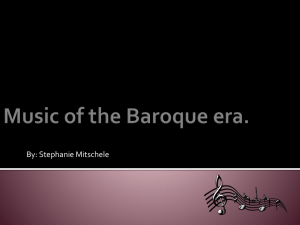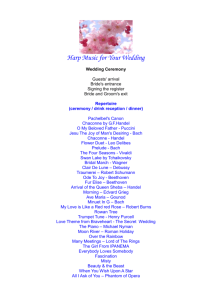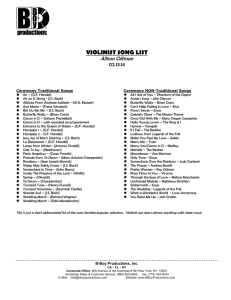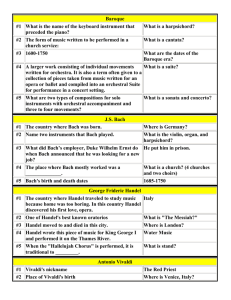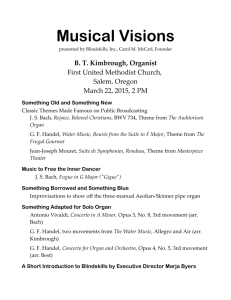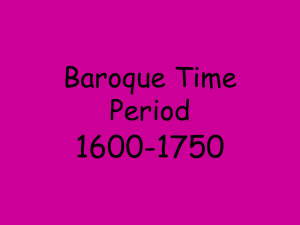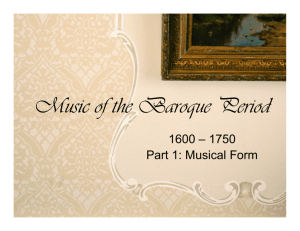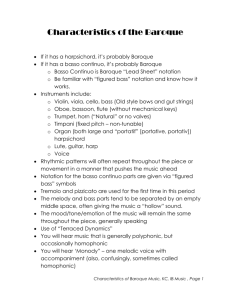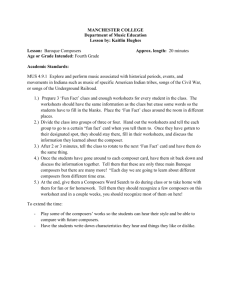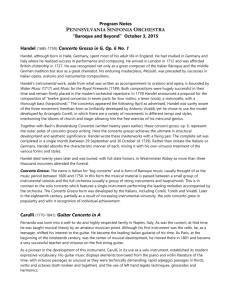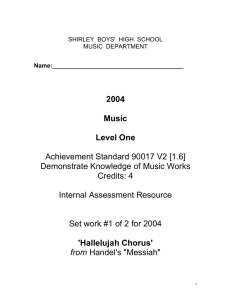Baroque Period 1600-1750 The word
advertisement
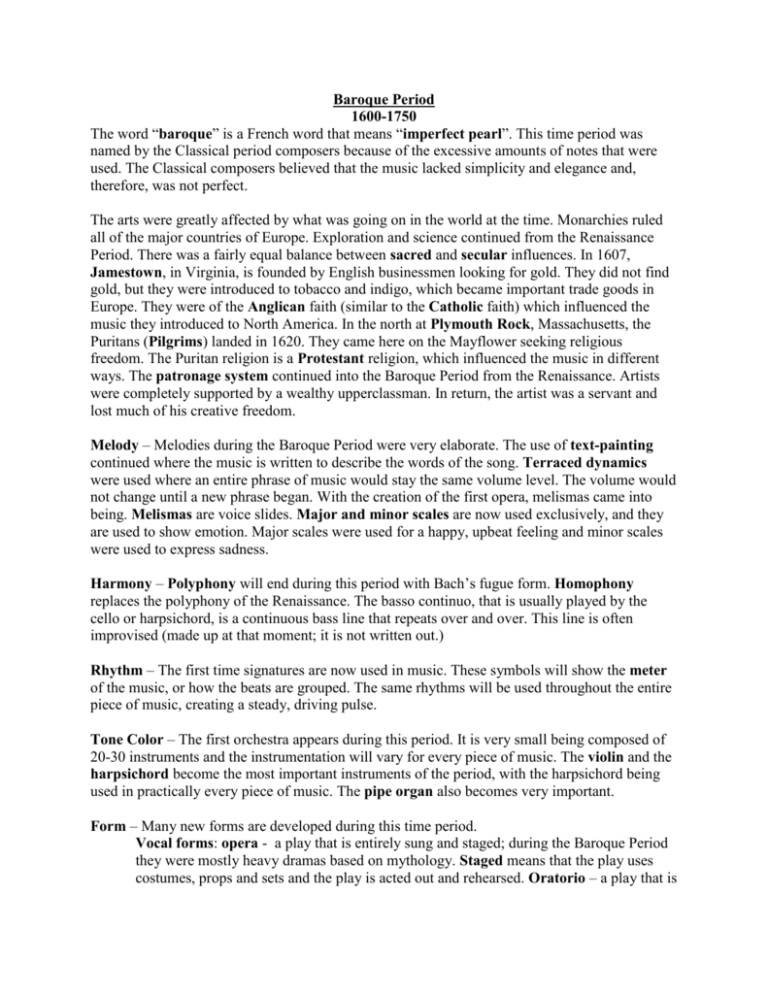
Baroque Period 1600-1750 The word “baroque” is a French word that means “imperfect pearl”. This time period was named by the Classical period composers because of the excessive amounts of notes that were used. The Classical composers believed that the music lacked simplicity and elegance and, therefore, was not perfect. The arts were greatly affected by what was going on in the world at the time. Monarchies ruled all of the major countries of Europe. Exploration and science continued from the Renaissance Period. There was a fairly equal balance between sacred and secular influences. In 1607, Jamestown, in Virginia, is founded by English businessmen looking for gold. They did not find gold, but they were introduced to tobacco and indigo, which became important trade goods in Europe. They were of the Anglican faith (similar to the Catholic faith) which influenced the music they introduced to North America. In the north at Plymouth Rock, Massachusetts, the Puritans (Pilgrims) landed in 1620. They came here on the Mayflower seeking religious freedom. The Puritan religion is a Protestant religion, which influenced the music in different ways. The patronage system continued into the Baroque Period from the Renaissance. Artists were completely supported by a wealthy upperclassman. In return, the artist was a servant and lost much of his creative freedom. Melody – Melodies during the Baroque Period were very elaborate. The use of text-painting continued where the music is written to describe the words of the song. Terraced dynamics were used where an entire phrase of music would stay the same volume level. The volume would not change until a new phrase began. With the creation of the first opera, melismas came into being. Melismas are voice slides. Major and minor scales are now used exclusively, and they are used to show emotion. Major scales were used for a happy, upbeat feeling and minor scales were used to express sadness. Harmony – Polyphony will end during this period with Bach’s fugue form. Homophony replaces the polyphony of the Renaissance. The basso continuo, that is usually played by the cello or harpsichord, is a continuous bass line that repeats over and over. This line is often improvised (made up at that moment; it is not written out.) Rhythm – The first time signatures are now used in music. These symbols will show the meter of the music, or how the beats are grouped. The same rhythms will be used throughout the entire piece of music, creating a steady, driving pulse. Tone Color – The first orchestra appears during this period. It is very small being composed of 20-30 instruments and the instrumentation will vary for every piece of music. The violin and the harpsichord become the most important instruments of the period, with the harpsichord being used in practically every piece of music. The pipe organ also becomes very important. Form – Many new forms are developed during this time period. Vocal forms: opera - a play that is entirely sung and staged; during the Baroque Period they were mostly heavy dramas based on mythology. Staged means that the play uses costumes, props and sets and the play is acted out and rehearsed. Oratorio – a play that is entirely sung, but not staged; during the Baroque Period these were mostly sacred. Masque – this form is similar to today’s musical theatre; a play that is staged with spoken dialogue with lots of songs and dances added in. Cantata – is a mini-oratorio. Hymn – sacred songs used in the Protestant Church. They were written in the vernacular (the language of the people). Mass – sacred music used in the Catholic Church. They were in Latin until the 1960’s. Instrumental forms: concerto – This music was for a solo instrument, plus orchestra accompaniment. It usually has three movements. Sonata – this music was for a solo instrument with keyboard accompaniment. Ballet – a play that is entirely danced to. Dance Suite – this was a collection of different dance tunes that were put together to be performed for an audience rather than being danced to. Fugue – was an instrumental round. Toccata – it means “touch piece” in Italian and usually has many very fast notes to show off the performer’s ability. Italian becomes the official language of music. The music capital of the world is Venice, Italy. American Music In 1607, English businessmen settled Jamestown, Virginia. They were looking for gold but, instead, found tobacco and indigo. They were of the Anglican faith which is very similar to Catholic. This means that they used the Mass in their worship. They also brought many secular folk songs and dances with them. In 1620, the Pilgrims landed at Plymouth Rock, Massachusetts. They were of the Puritan (Protestant) faith and came here seeking religious freedom. They believed that they were the one pure faith. Since they were a Protestant religion, they brought hymns with them. These hymns were based on the Book of Psalms in the Bible and were called Psalmody. These songs were in the vernacular, unaccompanied, not very rhythmic, and had very simple melodies that could be easily memorized. The hymns were taught by a method called “lining out”. A leader would sing a phrase and the congregation would repeat it back over and over until it was memorized. Composers Antonio Vivaldi was born in Venice, Italy. He lived from 1678-1741. His father was a professional violinist at St. Mark’s Cathedral. He was taught to play the violin by his father. While growing up, he studied music and religion. When the time came to choose a profession, he chose the priesthood. He was called “The Red Priest” because of his long red hair. After only a year, he was forced to leave the priesthood because of asthma. He decided to pursue a music career but he needed a patron. Vivaldi was chosen to compose, teach and direct the orchestra of an all-girl orphanage for over 35 years. He developed the three movement concerto form that we still use today. He composed at least one concerto for every instrument that existed at the time. He composed well over 500 concertos during his lifetime. Several of his most famous works are: The Four Seasons was a collection of four violin concertos: Summer, Winter, Spring and Fall. These particular concertos are good examples of “program music”. Program music is written so that the music tells a story. The composer wants everyone in the audience to leave with the same picture in their heads. Your listening example will be the first movement of the Spring Concerto. Here you can hear the birds of spring, the wind, the rain, thunder and lightning. Gloria in Excelsis Deo is a Mass. It is in Latin. The Concerto for Lute in d minor is often played today with the guitar as the solo instrument. You will hear solo guitar and orchestra accompaniment. The lute was the ancestor of the guitar. You can find these listening examples on Youtube. George Frederick Handel was born in Halle, Germany and lived from 1685-1758. His father was a well-known and respected barber-surgeon. His father wanted Handel to become a lawyer, not a musician. Handel’s aunt secretly gave him a clavichord and put it in the attic. Handel taught himself to play it. At age seven, his father took him to the Duke’s palace. While his father attended to the Duke, Handel found the music room and began to play the organ. When his father and the Duke found him, his father was furious. However, the Duke, recognizing Handel’s great talent, ordered the father to provide Handel with music instruction. Handel studied the harpsichord, violin, oboe and composition. At age twelve, he became the assistant organist of Halle. After his father’s death, the Duke became his patron. Handel asked to go to Venice where a new form called opera was developing. While studying in Venice, opera became his favorite form of music. He then asked to go to England where he introduced opera and quickly became very successful and famous. The Duke then decided to call Handel back to Germany to fulfill his duties. This did not make Handel happy. When the King of England died, the Duke was next in line and became the King of England. Handel was able to return to England with the Duke. He later became an English citizen. Toward the end of his life he went blind. He was buried with honor in Westminster Abbey. He composed over 50 operas. He also developed the oratorio and composed 20 of them. His most famous oratorio is the Messiah, which is the complete lifestory of Jesus Christ. The last movement is the Hallelujah Chorus which celebrates Christ’s resurrection. He also composed much instrumental music. The Water Music is a dance suite that was composed to entertain the King’s guests as they floated down the Thames River on a barge. Your listening example will be The Hornpipe from this piece. A hornpipe was a sailor’s dance. Listen for the French horns answering back and forth with the orchestra. The last listening example is also a dance suite, La Rejouissance from The Royal Fireworks was written to celebrate the end of a long war. It was to accompany a celebration featuring a large fireworks display. Johann Sebastian Bach was born in Eisenach, Germany and lived from 1685-1750. His death marks the end of the Baroque Period. He was surrounded by music since his birth since most of his relatives were musicians. At an early age he was taught to play the violin by his father. Before Bach was ten, his parents died and he went to live with an older brother. Bach continued his musical training on the clavichord, harpsichord, organ and composition. At age 15 he left his brother’s home to start his musical career. His fame as an organist spread. Bach was very religious. His patron became the Lutheran church. He dedicated every one of his 1,000 pieces of music “To the Glory of God”. He was married twice and between his two wives, he had 20 children, four of whom became famous composers. Toward the end of his life he went blind. Ten days before he died he suffered a stroke and regained his eyesight. He composed over 295 cantatas, many hymns, Masses, fugues, oratorios and instrumental works. His book The Well-Tempered Clavier was written as a keyboard instruction book for his family. The music in this book is so good that it is used for performance pieces today. One of your listening examples is from one of his cantatas, Jesu, Joy of Man’s Desiring. The Toccata and Fugue in d minor is a very famous piece of music that he wrote for himself to play on the organ. The last listening example is from the Brandenburg Concerto #2, 3rd movement where you will hear solo recorder, oboe, trumpet and violin solos.
